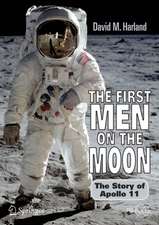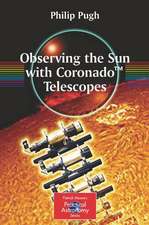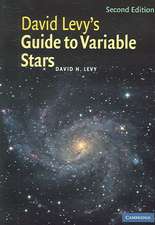A Visual Astronomer's Photographic Guide to the Deep Sky: A Pocket Field Guide: Astronomer's Pocket Field Guide
Autor Stefan Rumistrzewiczen Limba Engleză Paperback – noi 2010
Preț: 264.79 lei
Nou
Puncte Express: 397
Preț estimativ în valută:
50.67€ • 52.60$ • 42.25£
50.67€ • 52.60$ • 42.25£
Carte disponibilă
Livrare economică 04-18 martie
Preluare comenzi: 021 569.72.76
Specificații
ISBN-13: 9781441972415
ISBN-10: 1441972412
Pagini: 354
Ilustrații: X, 344 p. 502 illus., 2 illus. in color.
Dimensiuni: 127 x 203 x 23 mm
Greutate: 0.66 kg
Ediția:2010
Editura: Springer
Colecția Springer
Seria Astronomer's Pocket Field Guide
Locul publicării:New York, NY, United States
ISBN-10: 1441972412
Pagini: 354
Ilustrații: X, 344 p. 502 illus., 2 illus. in color.
Dimensiuni: 127 x 203 x 23 mm
Greutate: 0.66 kg
Ediția:2010
Editura: Springer
Colecția Springer
Seria Astronomer's Pocket Field Guide
Locul publicării:New York, NY, United States
Public țintă
Popular/generalCuprins
Observing Plans and Techniques.- Accessories and ‘Pimping’ Your ‘Scope.- Sketching.- Constellation Observing Lists and Photos.- Observation Records.
Notă biografică
My love affair with the cosmos began, probably, when I stared, open-jawed, for two hours at the film Star Wars. Although I was only three at the time, I can remember subsequently drawing pictures of stars and planets and ‘X-wings.’ I quickly became a science fiction addict, watching re-runs of Star Trek and various other series. And so, I desperately wanted a way of seeing some of these objects for myself. My parents bought me a cheap (supermarket) ‘scope when I was 11, which I then proceeded to set up in my sister’s room (the only one with a southernly view) and stargaze through her window. Neither my father nor I could ever get it to focus properly. Of course, at the time, I had no knowledge or understanding of air currents, seeing, or indeed how to use a telescope or star chart. Nevertheless, even with the horrendous optics of this small telescope I could make out some craters on the Moon – I was hooked! I decided to ‘save up’ for something better. After several birthdays I finally bought myself a reasonable ‘scope – a 9.25 inch Dobsonian, and spent many a clear night sitting on the garage roof (my sister wanted her room back!) gazing at the wonders of the universe.Soon after, university beckoned. I studied Chemistry, with a subsidiary in Astronomy. Although I very much enjoyed the latter, I was unable to continue as the university (at the time) did not offer Astronomy as a major degree. And so, my hobby took an enforced break, which was then extended by teacher training, getting married, and emigrating to east Africa. It was there, under the clear equatorial skies of Kenya, that my love of the cosmos was rekindled and my wife bought me a 5” Newtonian telescope for my birthday. I was astonished by the things I was able to see with such a small aperture. It just goes to show the difference a truly dark sky makes.Since then, I have been interested in visual astronomy and what deep sky objects really look like. Having subsequently returnedto the UK and settled in South Bedfordshire, I developed a keen interest in sketching at the eyepiece and have spent many a nocturnal hour gazing through my ‘scope, having told my wife I wouldn’t be outside for ‘too long.’Eventually, I began to wonder why there wasn’t a book that showed photographs of the ‘visual’ image (i.e., what can be seen at the eyepiece). It seemed that descriptions of DSOs varied slightly from writer to writer and Hubble Space Telescope images told me very little about what I could actually see in my backyard. That was how this book was conceived. And so now, here it is......I trust that it will give you as much pleasure to read as it was for me to write.Enjoy and clear skies!
Textul de pe ultima copertă
How many times have you ‘found’ a deep sky object (DSO), ticked it off the list, and moved on, or used the ‘Tour’ function on your GO-TO ‘scope and said, ‘Oh that’s a just a smudge’ or ‘Can’t see it – I’ll move on to the next one.’ If this has happened to you, then this book is for you. It will challenge you to go back to the ‘smudge’ and really look. Can you see the faint wisp or the detail in the southeastern corner? Can you see the small cluster within the cluster? Try to classify the open cluster for yourself. Compare it to the ‘accepted’ Trumpler classification. Whether you have a GO-TO ‘scope or not, this book gets you to rediscover one of the great things that got you into this hobby in the first place – looking through the eyepiece of a telescope. So pack away the DSLR, CCD camera, the guide ‘scope, and laptop and open your pencil case! You’re in for some fun!
Caracteristici
Illustrates exactly what deep sky objects will actually look like when observed, not as they look with enhanced imaging and processing Provides various techniques to help develop the reader's observing skills, as well as tips to improve sketching and recording Challenges observers to push the limits of their own observations



















